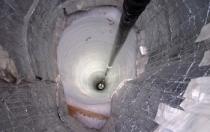
IceCube, the world’s largest observatory ever built to detect the elusive sub-atomic particles called neutrinos, has just been completed in the crystal-clear ice at the South Pole. Trillions of neutrinos stream through the human body at any given moment, but they rarely interact with regular matter, and researchers want to know more about them. The observatory provides an innovative means to investigate the sources and properties of neutrinos, which originate in some of the most spectacular phenomena in the universe.
Over a multi-year construction period, IceCube scientists melted 86 holes — each 1.5-miles deep — in the polar ice cap and inserted strings of light sensors into each hole. The water in each of the holes refroze, locking in an array of 5,160 light sensors, all connected to surface computers near the National Science Foundation’s Amundsen-Scott South Pole Station.
“We started drilling the holes with hot water in the ice at the geographic South Pole in 2003 and now, after seven years of work in bone-chilling temperatures, we have completed our ice-bound observatory, the world’s first large-scale neutrino telescope,” said Doug Cowen, an IceCube scientist and both a professor of physics and professor of astronomy and astrophysics at Penn State, one of the leading institutions in the IceCube collaboration. “This telescope is large enough to hold about 1,000 football stadiums as large as the one at Penn State — or a very close-packed arrangement of all the humans now living on Earth,” Cowen said.
The IceCube scientists designed the telescope to discover neutrinos with energies far exceeding those produced by man-made particle accelerators. These ultra-high-energy neutrinos may be produced in such cataclysmic astrophysical events as violent explosions of gamma-ray bursts and in the energetic particle jets powered by massive black holes. Lower-energy neutrinos are known to come from the Sun, and others at higher energies come from cosmic rays interacting with the Earth’s atmosphere and dramatic astronomical sources such as exploding supernovae in the Milky Way and other distant galaxies.
Neutrinos are uniquely useful to space scientists because, unlike light, they race toward Earth in straight lines from their unimaginably distant birthplaces unhindered by any matter or radiation that they pass through along the way, making them a unique probe into the universe.
“Neutrinos are pathologically anti-social particles and they are the only known particles that can emerge unscathed from deep within the thick surrounding armor of matter and radiation that envelops their dense, violent birthplaces,” Cowen said.
Penn State scientists have been involved since the beginning of the IceCube project, one of the most ambitious and complex multinational scientific projects ever attempted. Penn State scientists have made about 20 trips to the South Pole, led by Cowen and Tyce DeYoung, an IceCube scientist and an assistant professor of physics at Penn State. The Penn State team helped to deploy light sensors into the melted holes in the ice and to calibrate and test the sensors after they were refrozen in solid ice there.
Because neutrinos are very small and rarely collide with anything, the IceCube telescope needs to be gigantic in order to increase the probability of detectable collisions.
“Size also matters because a neutrino snared at these astronomical energies packs a wallop, creating a tidal wave of light that can illuminate sensors hundreds of meters away in the clear ice, and we want to see as much of the neutrino’s signature as possible,” Cowen said. IceCube records the rare collisions of neutrinos with the atomic nuclei of the observatory’s ice molecules, using its main detector’s 5,160 optical sensors.
“The physics community has wanted to build a detector such as this for more than 50 years, since before the Moon landings,” DeYoung said. “It has taken us this long because the detectors need to be so large and the technology only recently has evolved enough for us to build a detector like this by taking advantage of the extraordinary natural material that the Antarctic ice cap provides.”
DeYoung said the question he most wants to investigate with IceCube is the sources of the cosmic rays that constantly bombard Earth. “We hope that the neutrinos detected by IceCube will provide the smoking gun that tells us where the cosmic rays are produced, and maybe they also will give us clues about the processes that accelerate them to such high energies,” he said. “If we’re lucky, we may also find clues about the nature of dark matter, the mysterious stuff that makes up about five times as much of the universe as all the stars, planets, and other normal matter combined. It’s tremendously exciting to finally be completing this detector, and to be able start investigating these questions in earnest.”
The National Science Foundation (NSF) contributed $242 million toward the total project cost of $279 million. The University of Wisconsin-Madison, the lead U.S. institution for the project, managed and coordinated the design and construction of the IceCube complex and of some of the unique software and components needed for the project, including the Enhanced Hot Water Drill, a unique machine that can penetrate more than two kilometers into the ice in less than two days. Francis Halzen, of the University of Wisconsin-Madison, is principal investigator for the project. In addition to researchers at universities and research labs in the United States, Belgium, Germany, and Sweden — the countries that funded the observatory — IceCube data are analyzed by the larger IceCube Collaboration, which also includes researchers from Barbados, Canada, Japan, New Zealand, Switzerland, and the United Kingdom.
“IceCube is not only a magnificent observatory for fundamental astrophysical research, it is the kind of ambitious science that can only be attempted through the cooperation — the science diplomacy, if you will — of many nations working together in the finest traditions of Antarctic science toward a single goal,” said Karl A. Erb, director of the National Science Foundation Office of Polar Programs.
To see video and photos associated with this project, visit http://www.nsf.gov/news/news_images.jsp?cntn_id=118236&org=NSF online.
Barbara Kenney, Penn State University


